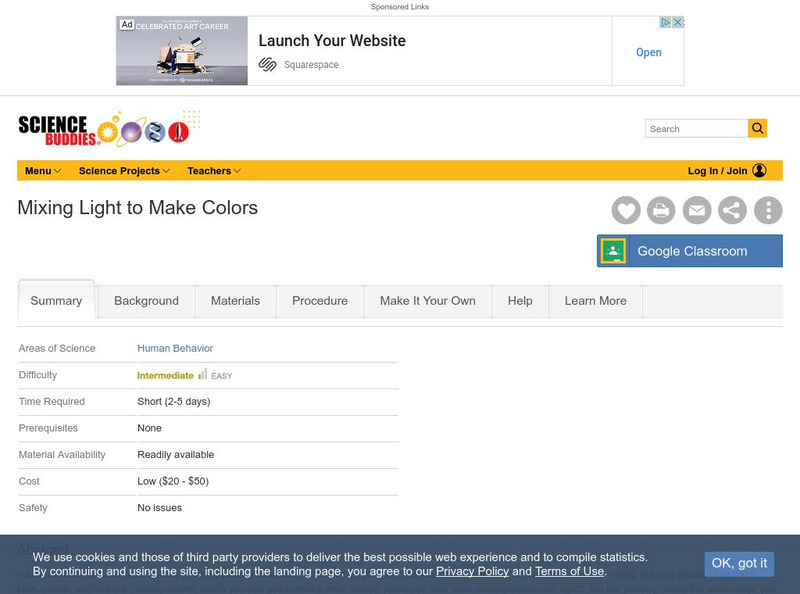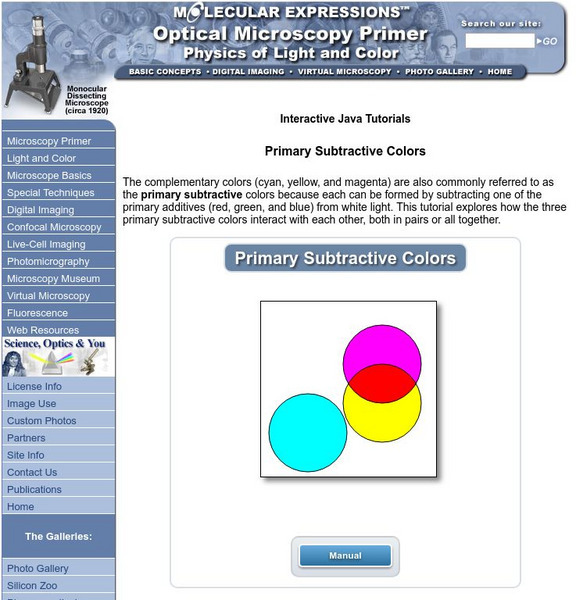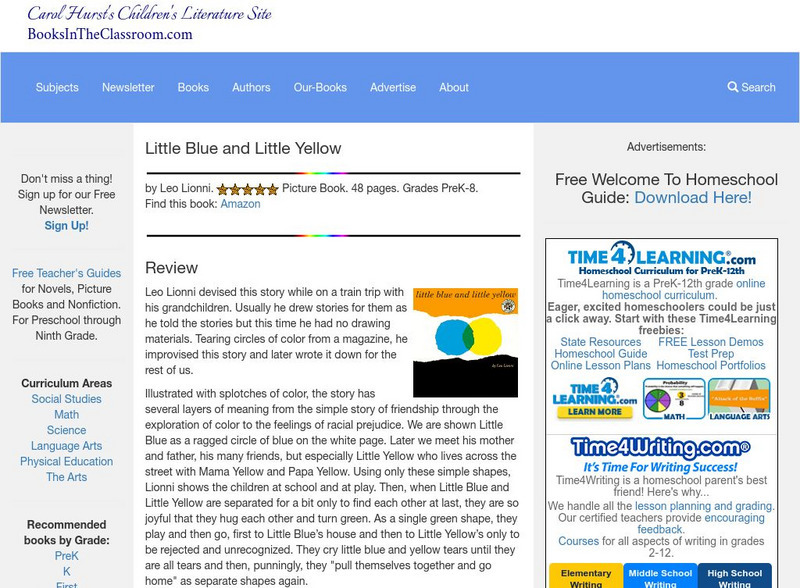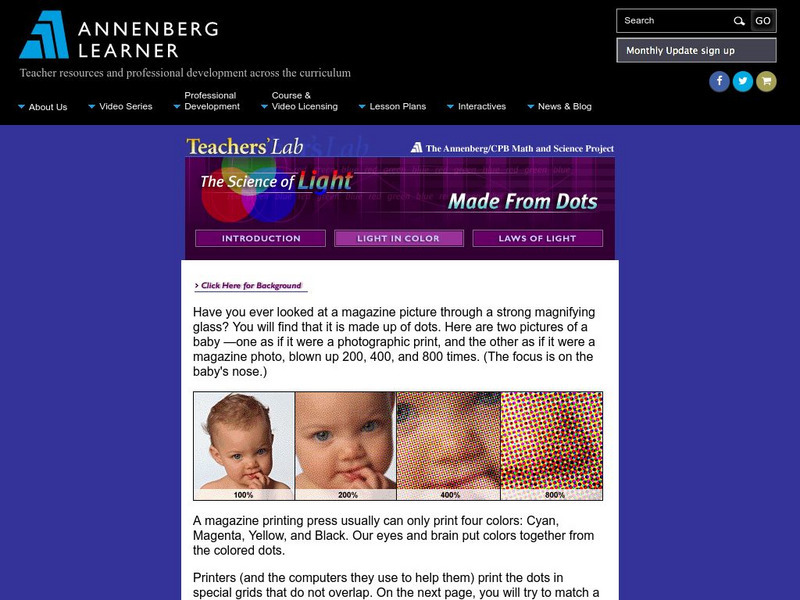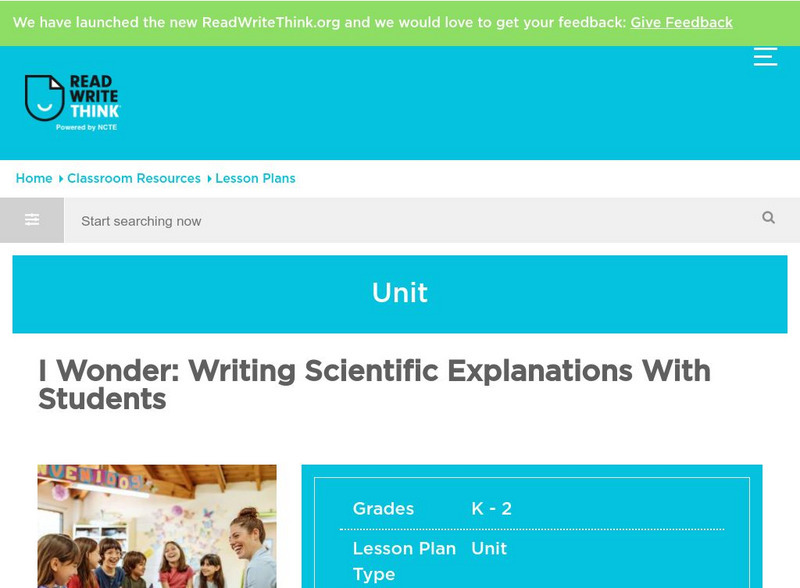Curated OER
Explorit's Green Salad Quiz
In this food history instructional activity, students read the information about the history of food and salads. Students select the correct answer for the 6 related questions.
Curated OER
Rainbow in a Baggie
Students create rainbows in a bag. In this art activity, students create rainbows using cornstarch, water, sugar and food coloring.
Curated OER
ESL Vegetable Activity
In this ESL vegetables worksheet, students read descriptions of vegetables and determine which is being described. Students may click on an answer button for immediate feedback.
Curated OER
Faces of a Cube
Students identify and correctly name three-dimensional solids; cones, spheres, and cubes. In this three-dimensional figures lesson, students build a cube by matching colored square faces to a correct word. Students then...
Curated OER
Cool Math
Students benefit from the correctly selected book for a specific math concept. In this book selection lesson, students are given a list of books related to specific math concepts. Students' ages can range from pre-school to...
Curated OER
Solar System Distance Activity
Students examine the distances between the Sun, planets, and smaller objects in the Solar System. They design a model using beads that shows the scale distances of the Solar System using astronomical units converted into a 10 centimeter...
Curated OER
Leaf Worksheet
In this leaf classification worksheet, students count the number of leaves and write the number in the color column for each day leaves were collected. Students then answer the four questions.
Science Buddies
Science Buddies: Mixing Light to Make Colors
You know how to make new colors by mixing paint or crayons. For example, you get green by mixing yellow and blue, or orange by mixing red and yellow. With paint, blue, yellow, and red are primary colors, which you can use to make other...
Florida State University
Florida State University: Molecular Expressions: Primary Subtractive Colors
Manipulate "pigmented" color discs to see how mixing subtractive colors affect the overall color.
Books in the Classroom
Carol Hurst's Children's Literature Site: Little Blue and Little Yellow
This site on the book "Little Blue and Little Yellow" by Leo Lionni, includes a review of the book, a listing of things to notice and talk about, activities related to the book, other related books, and links to other resources.
Alabama Learning Exchange
Alex: Leo Lionni's Little Blue and Little Yellow
Students will use Leo Lionni's literature and his website to learn about the author, mix primary colors, summarize and rewrite a story, and use graphing skills to determine the classes' favorite color.
Other
60 Second Science: Color Exploration I (Primary Colors Lesson Plan)
Discover what primary colors are and explore ways in which red, yellow, and blue can be mixed to create new colors.
TeachEngineering
Teach Engineering: Do Different Colors Absorb Heat Better?
Students test whether the color of a material affects how much heat it absorbs. Students will place an ice cube in a box made of colored paper (one box per color; white, yellow, red and black), which they will place in the sun. The...
PBS
Pbs Learning Media: Images of the Sun
We think of the sun as being bright yellow, however, the sun is actually different colors based on whether the sun is in an active stage. Scientists used telescopes and satellite cameras to take these stunning photographs of the sun....
PBS
Pbs Kids Afterschool Adventure!: Operation: Rainbow Math Activity Plan
Red apples, orange candles, yellow stars, green frogs, and blue, indigo, and violet flowers-they all add up to Rainbow Math fun! During this adventure children learn the colors of the rainbow as they practice counting, adding and...
Mocomi & Anibrain Digital Technologies
Mocomi: What Is Pigment?
Discusses the properties of pigment and the colors of blue, red, green, and yellow.
Curated OER
Yellow Ribbon Tied Around Tree
Different colors have different meanings in different places. Check out these interesting facts about the meanings of colors, you might learn some things about your favorite color.
The Tech Interactive
Tech Museum of Innovation: Common Light Sources
While reviewing various light sources, the source of colors (white, red, yellow, blue) are also discussed. The bouncing of light, the matching of colors, and seeing colors are all highlighted.
Other
History, Definitions,& Techniques of Oil Painting
Artist Ron Sanders presents a comprehensive look at oil colors and painting techniques prior to the 20th century. Explanation of mediums, grounds, supports, pigments, techniques and much more. Quotes from and about master artists and...
Science Education Resource Center at Carleton College
Serc: Water Color Mixing
In this classroom lab activity, students will experiment with mixing the primary colors together: red, yellow, and blue, to determine what new colors may be observed.
Annenberg Foundation
Annenberg Learner: Made From Dots
Notice how magazines print photos using dots made up of percentages of only three colors and black. Try your hand at using percentages of cyan, magenta and yellow to match the magazine color displayed.
Ed Koday
Web Archive: Luna Moths
Luna moths are one of the most unusual and beautiful of the North American moths known as Saturnidae. They are well known for their green-yellow colors and long tails,and although they are often seen in pictures, they are a real surprise...
Illustrative Mathematics
Illustrative Mathematics: 7.sp Waiting Times
Suppose each box of a popular brand of cereal contains a pen as a prize. The pens come in four colors, blue, red, green and yellow. Each color of pen is equally likely to appear in any box of cereal. Design and carry out a simulation to...
ReadWriteThink
Read Write Think: I Wonder: Writing Scientific Explanations With Students
Students choose a question to explore, research it using a variety of resources, organize their information on a TCF chart, and then collaboratively write a class scientific explanation.







